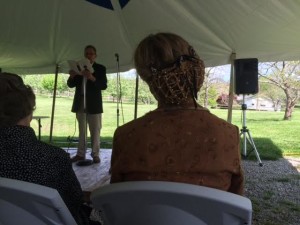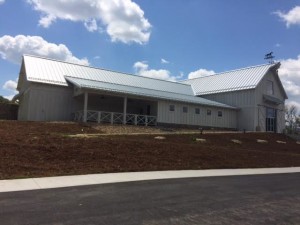
Until this year, the “museum” portion of the Laura Ingalls Wilder Historic Home and Museum in Mansfield, Missouri was housed inadequately. Adjacent to the farmhouse lovingly built by Almanzo Wilder (with help from local carpenters, particularly in the final phase of construction) and designed by his wife, Laura, the museum was constructed in 1971 and looked it. Beyond that lay the combination bookstore/gift shop in a smaller, separate structure. Everything was, in a word, crowded.
(For TV news footage from the dedication, click here.)

The view of the museum from the lawn of Rocky Ridge farmhouse (photo courtesy LIWLRA member Lauri Goforth)
After the ribbon-cutting in front of the museum, the crowd migrated to the farmhouse where, accompanied by the springtime Missouri breeze, they took seats under a tent and Laura biographers William Anderson and Pamela Smith Hill addressed the crowd with prepared remarks.

Pamela Smith Hill listens to Bill Anderson at Rocky Ridge Farm in Mansfield, Missouri on the day of the dedication of the new museum for the Laura Ingalls Wilder Home and Museum, April 22, 2016 (Sandra Hume photo)
Anderson then talked about the building dated from the 1960s that served as, in total, the museum curator’s house, the bookstore, and office space as well as the 1971 building that housed the museum until this year. Both buildings will be razed to make the property look more like how it was when the Wilders lived here.
Pamela Smith Hill, editor and annotator of 2014’s unexpected runaway bestseller Pioneer Girl, stepped to the microphone next. (A Missouri native, Pamela was supported in the audience by members of her family.) She talked of Laura’s writing, how it had “power, grace, and emotional depth,” and how she was an “instinctive storyteller who understood the power of language and how it could pull readers directly into a scene.” Among other passages, she shared one from Pioneer Girl that had been pulled directly from Laura’s unedited rough draft, written in pencil, which readers might have recognized from By the Shores of Silver Lake. “She understood how language itself could create a character, a scene, or bring a setting to life.”
In an emotional moment, Laura Ingalls Wilder Historic Home and Museum board member Dr. John Moore (a recent board member who joined during the recent capital campaign) stood to announce that the museum was going to be dedicated to the tireless Jean Coday.
Bill Anderson took the stage once again to thank the audience, concluding, “This is one of the monumental days of the Wilder Home Association.”
It was truly a magical day.
Edited to add that Bill Anderson contacted us for clarifications:
L.D. Lichty was the mover and shaker and first president of the group determined to preserve the Wilder Home. He and his wife Irene were co-curators when the house was opened regularly,sharing the duties. When L.D.died in 1974, Irene continued, with help from family members. The curators’ home was built by Rose. It was a residence for the Lichtys. In more recent years it was the bookstore and office space.


Comments2
L.D. Lichty was the mover and shaker and first president of the group determined to preserve the Wilder Home. He and his wife Irene were co-curators when the house was opened regularly,sharing the duties. When L.D.died in 1974, Irene continued, with help from family members. The curators’ home was built by Rose. It was a residence for the Lichtys. In more recent years it was the bookstore and office space.
Hi,
I was at Laura’s house in Mansfield a couple of years ago. There was a pond down the hill from her house. Is that where the new museum was built?
Thank you,
Stephanie Edelen
Comments are closed.